State-of-the-Art and Practical Guide to Ultrasonic Transducers for Harsh Environments Including Temperatures above 2120 °F (1000 °C) and Neutron Flux above 1013 n/cm2
Abstract
:1. Introduction
2. Transducers for High Temperature Applications
2.1. Single-Crystal Wafers
2.2. Thick-Film Ceramics
2.3. Composite Ceramics
3. Piezoelectric Materials for Radiation Environment
- (1)
- depoling via thermal spike processes,
- (2)
- morphization/metamictization due to displacement spikes or high concentration of point defects,
- (3)
- increase in point defect concentration, and
- (4)
- development of defect aggregates.
3.1. Temperature Tolerance
3.2. Radiation Tolerance
4. Spray-On Transducers for Harsh Environment Applications
- Select the powder (BIT or lithium niobate/barium titanate) and mix with Ceramabind 830 to achieve a 1:0.2:0.8 ratio (powder–binder–water by weight ratio); A plastic stirrer was used to rigorously mix the powder and binder, but it could be mixed with a ultrasonic horn.
- Create the solution by combining the mixed powder/binder with distilled water at the specified concentration in a 15 mL glass vial.
- Prepare the substrate by roughening the surface with a fine-grit sandpaper, and then clean it with isopropyl alcohol.
- Spray the slurry onto the substrate with an air gun (Goplus Electric Paint Sprayer, 450W High Power HVLP Paint Spray Gun with 3 Spray Patterns, 3 Nozzle Sizes, Adjustable Valve Knob and 900ml Large Detachable Container); The air gun pressure should be 20–22 psi and the nozzle should be approximately 20 cm from the surface. Alternatively, apply slurry with a brush.
- Dry each layer of the sprayed film in the relatively low-humidity environment (15–20%) of a glove box for at least 15 min to avoid cracking.
- Repeat steps 4 and 5 to achieve the desired film thickness (preferably thicker than 120 μm). The average thickness of a single spray is 18 μm.
- Use a thickness gage to measure the average thickness of the film.
- After the film layers have cured, brush apply a conductive silver paint (SPI Chemicals, Inc., Atlanta, GA, USA) on the portion of the film to become the transducer to a thickness of approximately 30 μm. Each layer takes approximately 15 min to cure in the low-humidity setting, so if there are eight spray repetitions, it will take about 2 h. For films thicker than eight layers, the cure time for a layer may be longer.
- Once the electrode is applied, heat the sample to 60 °C for a few minutes with a heat gun to allow the electrode to dry. This step is optional as the electrode can air dry in a longer time.
- Attach a bare nickel chrome wire (supplied by Consolidated) with silver paint to serve as the lead wire as shown in Figure 12.
- Pole sample at a desired electric field for at least 20 min at ambient temperature.
5. Conclusions
Author Contributions
Funding
Conflicts of Interest
References
- Baba, A.; Searfass, C.T.; Tittmann, B.R. High temperature ultrasonic transducer up to 1000°C using lithium niobate single crystal. AIP Appl. Phys. Lett. 2010, 97, 232901. [Google Scholar] [CrossRef]
- Parks, D.A.; Kropf, M.M.; Tittmann, B.R. Aluminum Nitride as a High Temperature Transducer. In Proceedings of the 36th Annual Review of Progress in Quantitative Nondestructive Evaluation, Kingston, RI, USA, 26–31 July 2009. [Google Scholar]
- Parks, D.A.; Zhang, S.; Tittmann, B.R. High-Temperature (>500 °C) Ultrasonic Transducers: An Experimental Comparison Among Three Candidate Piezoelectric Materials. IEEE Trans. Ultrason. Ferroelectr. Freq. Control 2013, 60, 1010–1015. [Google Scholar] [CrossRef] [PubMed]
- Searfass, C. Characterization of Bismuth Titanate Thick Films Fabricated Using a Spray-On Technique for High Temperature Ultrasonic Non-Destructive Evaluation. Ph.D. Thesis, The Pennsylvania State University, Stecker Ridge, PA, USA, 2012. [Google Scholar]
- Pheil, C.S. Fabrication and Testing of High Temperature Ultrasonic Transducers. Bachelor’s Thesis, The Pennsylvania State University, Stecker Ridge, PA, USA, 2012. [Google Scholar]
- Reinhardt, B. Nonlinear Ultrasonic Measurements in Nuclear Reactor Environments. Ph.D. Thesis, The Pennsylvania State University, Stecker Ridge, PA, USA, 2016. [Google Scholar]
- Trivedi, Y. Field-Deployable Guided Wave Transducers for High-Temperature Applications. Master’s Thesis, The Pennsylvania State University, Stecker Ridge, PA, USA, 2016. [Google Scholar]
- Ledford, K.R. Practical Sprayed-on Transducer Composites for High Temperature Applications. Master’s Thesis, The Pennsylvania State University, Stecker Ridge, PA, USA, 2015. [Google Scholar]
- Xu, J.L. Practical Ultrasonic Transducers for High Temperature Applications using Bismuth Titanate and Ceramabind. Master’s Thesis, The Pennsylvania State University, Stecker Ridge, PA, USA, 2017. [Google Scholar]
- MackertichSengerdy, G. Aluminum Nitride Transducer Design for Harsh Environment. Master’s Thesis, The Pennsylvania State University, Stecker Ridge, PA USA, 2018. [Google Scholar]
- Gao, Z.P.; Yan, H.X.; Ning, H.P.; Reece, M.J. Ferroelectricity of Pr2Ti2O7 ceramics with super high Curie point. Adv. Appl. Ceram. 2013, 112, 69–74. [Google Scholar] [CrossRef]
- Yan, H.; Ning, H.; Kan, Y.; Wang, P.; Reece, M.J. Piezoelectric Ceramics with Super-High Curie Points. J. Am. Ceram. Soc. 2009, 92, 2270–2275. [Google Scholar] [CrossRef]
- Ning, H.; Yan, H.; Reece, M.J. Piezoelectric Strontium Niobate and Calcium Niobate Ceramics with Super-High Curie Points. J. Am. Ceram. Soc. 2010, 93, 1409–1413. [Google Scholar] [CrossRef]
- Nanamatsu, S.; Kimura, M. Ferroelectric Properties of Ca2Nb2O7 Single Crystal. J. Phys. Soc. Jpn. 1974, 36, 1495. [Google Scholar] [CrossRef]
- Nanamats, S.; Kimura, M.; Doi, K.; Matsushi, S.; Yamada, N. A New ferroelectric: La2Ti2O7. Ferroelectrics 1974, 8, 511–513. [Google Scholar] [CrossRef]
- Kimura, M.; Nanamatsu, S.; Kawamura, T.; Matsushita, S. Ferroelectric, Electrooptic and Piezoelectric Properties of Nd2Ti2O7 Single Crystal. Jpn. J. Appl. Phys. 1974, 13, 1473–1474. [Google Scholar] [CrossRef]
- Gao, Z.; Lu, C.; Wang, Y.; Yang, S.; Yu, Y.; He, H. Super Stable Ferroelectrics with High Curie Point. Sci. Rep. 2016, 6, 24139. [Google Scholar] [CrossRef] [Green Version]
- Barrow, D.; Petroff, T.; Sayer, M. Thick ceramic coatings using a sol gel based ceramic-ceramic 0–3 composite. Surf. Coat. Technol. 1995, 76, 113–118. [Google Scholar] [CrossRef]
- Barrow, D.A.; Petroff, T.E.; Tandon, R.P.; Sayer, M. Characterization of thick lead zirconate titanate films fabricated using a new sol gel based process. J. Appl. Phys. 1997, 81, 876–881. [Google Scholar] [CrossRef]
- Kobayashi, M.; Olding, T.R.; Zou, L.; Sayer, M.; Jen, C.K.; Rehmen, A.U. Piezoelectric Thick Film Ultrasonic Transducers Fabricated by a Spray Technique. In Proceedings of the IEEE Ultrasonics Symposium, San Juan, PR, USA, 22–25 October 2000; pp. 985–989. [Google Scholar]
- Kobayashi, M.; Jen, C.K. Piezoelectric thick bismuth titanate/lead zirconate titanate composite film transducers for smart NDE of metals. Smart Mater. Struct. 2004, 13, 951–956. [Google Scholar] [CrossRef]
- Kobayashi, M.; Jen, C.K.; Nagata, H.; Hiruma, Y.; Tokutsu, T.; Takenaka, T. 10F-5 Integrated Ultrasonic Transducers above 500°C. In Proceedings of the 2007 IEEE Ultrasonics Symposium, New York, NY, USA, 28–31 October 2007; pp. 953–956. [Google Scholar]
- Kobayashi, M.; Jen, C.K.; Ono, Y.; Krüger, S. Lead-Free Thick Piezoelectric Films as Miniature High Temeprature Ultrasonic Transducer. In Proceedings of the IEEE Ultrasonic Symposium, Montreal, QC, Canada, 23–27 August 2004; pp. 910–913. [Google Scholar]
- Kobayashi, M.; Ono, Y.; Jen, C.K.; Cheng, C.C. High-Temperature Piezoelectric Film Ultrasonic Transducers by a Sol-Gel Spray Technique and Their Application to Process Monitoring of Polyymer Injection Molding. IEEE Sens. J. 2006, 6, 55–62. [Google Scholar] [CrossRef]
- Searfass, C.T.; Baba, A.; Tittmann, B.R.; Agrawal, D.K.; Thompson, D.O.; Chimenti, D.E. Fabrication and testing of microwave sintered sol-gel spray-on bismuth titanate-lithium niobate based piezoelectric composite for use as a high temperature (>500 °C) ultrasonic transducer. In Review of Progress in Quantitative Nondestructive Evaluation; Springer Science & Business Media: Berlin/Heidelberg, Germany, 2010; pp. 1035–1042. [Google Scholar]
- Searfass, C.T.; Tittmann, B.R.; Agrawal, D.K. Sol-gel Deposited Thick Film Bismuth Titanate Based Transducer Achieves Operation of 600 C. In Review of Progress in Quantitative Nondestructive Evaluation; Springer Science & Business Media: Berlin/Heidelberg, Germany, 2010; pp. 1751–1758. [Google Scholar]
- Searfass, C.T.; Parks, D.A.; Baba, A.; Tittmann, B.R. Testing of Single Crystal and Oriented Polycrystalline Piezoelectric Materials for Use as High Temperature (>500 degrees C) Ultrasonic Transducers. Presented at the 12th International Symposium on Nondestructive Characterization of Materials (NDCM-XII), Blacksburg, VA, USA, 19–24 June 2011. [Google Scholar]
- Searfass, C.T.; Baba, A.; Tittmann, B.R.; Agrawal, D.K. Spray-on Piezoelectric Bismuth Titinate and Bismuth Titinate-Lithium Niobate Transducers for High Temperature (>500 degrees C) Ultrasonic Nondestructive Evaluation. Presented at the 12th International Symposium on Nondestructive Characterization of Materials (NDCM-XII), Blacksburg, VA, USA, 19–24 June 2011. [Google Scholar]
- Cyphers, R.L. Low Frequency Testing of Ultrasonic Tranducers fabricated with a sol-gel Spray-on Procedure. Master’s Thesis, The Pennsylvania State University, Stecker Ridge, PA, USA, 2012. [Google Scholar]
- Sinclair, A.N.; Chertov, A.M. Radiation endurance of piezoelectric ultrasonic transducers—A review. Ultrasonics 2014, 57, 1–10. [Google Scholar] [CrossRef]
- Tittmann, B.R.; Reinhardt, B.; Parks, D.R. Nuclear Radiation Tolerance of Single Crystal Aluminum Nitride Ultrasonic Transducer. In Proceedings of the 2014 IEEE International Ultrasonics Symposium, Chicago, IL, USA, 3–6 September 2014. [Google Scholar] [CrossRef]
- Parks, D.A.; Tittmann, B.R. Radiation tolerance of piezolectric bulk single crystal aluminum nitride. IEEE Trans. Ultrason. Ferroelectr. Freq. Control 2014, 61, 1216–1222. [Google Scholar] [CrossRef]
- Reinhardt, B.; Daw, J.; Tittmann, B.R. Irradiation Testing of Piezoelectric (Aluminum Nitride, Zinc Oxide, Bismuth Titanate) and Magnetostrictive Sensors (Remendur and Galfenol). IEEE Trans. Nucl. Sci. 2018, 65, 533–538. [Google Scholar] [CrossRef]
- Anon. Evaluation of Irradiation Test Results for Candiate NERVA. In Piezoelectric Accelerometers, Ground Test Reactor Irradiation Test No. 22; Aerojet Nuclear Systems Company: Huntsville, AL, USA, 1971. [Google Scholar]
- Berger, L. Semiconductor Materials; CRC Press: Boca Raton, FL, USA, 1997. [Google Scholar]
- Baranov, V.M.; Martynenko, S.P.; Sharapa, A.I. Durability of ZTL piezoceramic under the action of reactor radiation. At. Energy 1982, 53, 803–804. [Google Scholar] [CrossRef]
- Brinkman, J.A. On the Nature of Radiation Damage in Metals. J. Appl. Phys. 1954, 25, 961. [Google Scholar] [CrossRef]
- Broomfield, G. The effect of low-fluence neutron irradiation on silver-electroded lead-zirconate-titanate piezoelectric ceramics. J. Nucl. Mater. 1980, 91, 23–34. [Google Scholar] [CrossRef]
- Dienes, G.J.; Vineyard, G.H. Radiation Effects in Solids; Interscience Publishers Inc.: New York, NY, USA, 1957. [Google Scholar]
- Friedland, E. Influence of electronic stopping on amorphization energies. Surf. Coat. Technol. 2007, 201, 8220–8224. [Google Scholar] [CrossRef]
- Glower, D.D.; Hester, D.L. Hysteresis Studies of Reactor-Irradiated Single-Crystal Barium Titanate. J. Appl. Phys. 1965, 36, 2175. [Google Scholar] [CrossRef]
- Glower, D.D.; Hester, D.L.; Warnke, D.F. Effects of Radiation-Induced Damage Centers in Lead Zirconate Titanate Ceramics. J. Am. Ceram. Soc. 1965, 48, 417–421. [Google Scholar] [CrossRef]
- Hobbs, L.W.; Clinard, F.W., Jr.; Zinkle, S.J.; Ewing, R.C. Radiation effects in ceramics. J. Nucl. Mater. 1994, 216, 291–321. [Google Scholar] [CrossRef]
- Hobbs, L.W.; Jesurum, C.E.; Berger, B. Rigid Constraints in Amorphization of Singly and Multiply-Polytopic Structures. In Rigidity Theory and Applications; Thorpe, M.F., Duxbury, P.M., Eds.; Kluwer Academic/Plenium Publishers: Heidelberg, Germany, 2000; pp. 191–216. [Google Scholar]
- Ito, Y.; Yasuda, K.; Ishigami, R.; Sasase, M.; Hatori, S.; Ohashi, K.; Tanaka, S.; Yamamoto, A. Radiation damage of materials due to high-energy ion irradiation. Nucl. Instrum. Methods Phys. Res. Sect. B Beam Interact. Mater. Atoms 2002, 191, 530–535. [Google Scholar] [CrossRef]
- Kazys, R.; Voleisis, A.; Sliteris, R.; Mazeika, L.; Van Nieuwenhove, R.; Kupschus, P.; Abderrahim, H.A. High temperature ultrasonic transducers for imaging and measurements in a liquid Pb/Bi eutectic alloy. IEEE Trans. Ultrason. Ferroelectr. Freq. Control. 2005, 52, 525–537. [Google Scholar] [CrossRef] [PubMed]
- Lefkowitz, I. Radiation-Induced Changes in the Ferroelectric Properties of Some Barium Titanate-Type Materials. J. Phys. Chem. Solids 1958, 10, 169–173. [Google Scholar] [CrossRef]
- Meldrum, A.; Boatner, L.; Weber, W.; Ewing, R.; Boatner, L.; Weber, W. Amorphization and recrystallization of the ABO3 oxides. J. Nucl. Mater. 2002, 300, 242–254. [Google Scholar] [CrossRef]
- Meleshko, Y.P.; Babaev, S.V.; Karpechko, S.G.; Nalivaev, V.I.; Safin, Y.A.; Smirnov, V.M. Studying the electrophysical parameters of piezoceramics of various types in an IVV-2M reactor. At. Energy 1984, 57, 544–548. [Google Scholar] [CrossRef]
- Miclea, C.; Miclea, C.F.; Spanulescu, I.; Cioangher, M.; Tănăsoiu, C. Effect of neutron irradiation on some piezoelectric properties of PZT type ceramics. J. Phys. 2005, 128, 115–120. [Google Scholar] [CrossRef]
- Primak, W.; Anderson, T.T. Metamimictization of Lithium Niobate by Thermal Neutrons. Nucl. Technol. 1975, 23, 235–248. [Google Scholar]
- Rempe, J.; MacLean, H.; Schley, R.; Hurley, D.; Daw, J.; Taylor, S.; Smith, J.; Svoboda, J.; Kotter, D.; Knudson, D.; et al. Strategy for Developing New in-Pile Instrumentation to Support Fuel Cycle Research and Development; Idaho National Laboratory: Idaho Falls, ID, USA, 2011.
- Sickafus, K.E.; Kotomin, E.A.; Ub, B.P. Radiation Effects in Solids (Proceedings of the NATO Advanced Study Institute on Radiation Effects in Solids); NATO Science Series; Springer: Erice, Italy, 2007. [Google Scholar]
- Szenes, G. Ion-induced amorphization in ceramic materials. J. Nucl. Mater. 2005, 336, 81–89. [Google Scholar] [CrossRef]
- Szenes, G. Thermal spike analysis of ion-induced tracks in semiconductors. Nucl. Instrum. Methods Phys. Res. Sect. B Beam Interact. Mater. Atoms 2011, 269, 2075–2079. [Google Scholar] [CrossRef]
- Thomas, R.L. Vibration Instrumentation for Nuclear Reactors; Endevco Technical Report 258; Los Alamos National Lab.: Los Alamos, NM, USA, 1973; pp. 1–8.
- Trachenko, K. Understanding resistance to amorphization by radiation damage. J. Phys. Condens. Matter 2004, 16, R1491–R1515. [Google Scholar] [CrossRef]
- Trachenko, K.; Pruneda, J.M.; Artacho, E.; Dove, M.T.; Pruneda, M. How the nature of the chemical bond governs resistance to amorphization by radiation damage. Phys. Rev. B 2005, 71, 1–5. [Google Scholar] [CrossRef]
- Yano, T.; Inokuchi, K.; Shikama, M.; Ukai, J.; Onose, S.; Maruyama, T. Neutron irradiation effects on isotope tailored aluminum nitride ceramics by a fast reactor up to 2 × l026 n/m2. J. Nucl. Mater. 2004, 329, 1471–1475. [Google Scholar] [CrossRef]
- Zhang, S.; Yu, F. Piezoelectric Materials for High Temperature Sensors. J. Am. Ceram. Soc. 2011, 94, 3153–3170. [Google Scholar] [CrossRef]
- Kong, X.Y.; Ding, Y.; Yang, R.; Wang, Z.L. Single-Crystal Nanorings Formed by Epitaxial Self-Coiling of Polar Nanobelts. Science 2004, 303, 1348–1351. [Google Scholar] [CrossRef] [Green Version]
- Parks, D.A.; Reinhardt, B.T.; Tittmann, B.R. Piezoelectric Material for Use in a Nuclear Reactor Core. Presented at the Review of Progress in Quantitative Nondestructive Evaluation, Burlington, VT, USA, 17–22 July 2011; pp. 1633–1639. [Google Scholar]
- Reinhardt, B.T.; Parks, D.A.; Tittmann, B.R. Measurement of Irradiation Effects in Precipitate Hardened Aluminum Using Nonlinear Ultrasonic Principles (In-Situ). Presented at the Review of Progress in Quantitative Nondestructive Evaluation, Burlington, VT, USA, 17–22 July 2011; pp. 1648–1654. [Google Scholar]
- Reinhardt, B.T.; Searfass, C.T.; Pheil, C.; Sinding, K.; Cyphers, R.; Tittmann, B.R. Fabrication of Bismuth Titanate-PZT Ceramic Transducers for High Temperature Applications. In Proceedings of the Review of Progress in Quantitative NDE, Denver, CO, USA, 15–20 July 2012. [Google Scholar]
- Reinhardt, B.T.; Parks, D.A.; Tittmann, B.R. Selecting a Radiation Tolerant Piezoelectric Material for Nuclear Reactor Applications. In Proceedings of the Review of Progress in Quantitative NDE, Denver, CO, USA, 15–20 July 2012. [Google Scholar]
- Daw, J.; Tittmann, B.; Reinhardt, B.; Kohse, G.; Ramuhalli, P.; Montgomery, R.; Chien, H.T.; Villard, J.F.; Palmer, J.; Rempe, J. Irradiation testing of ultrasonic transducers. In Proceedings of the 2013 3rd International Conference on Advancements in Nuclear Instrumentation, Measurement Methods and Their Applications (ANIMMA), Marseille, France, 23–27 June 2013. [Google Scholar]
- Sinding, K.; Searfass, C.; Malarich, N.; Reinhardt, B.; Tittmann, B.R. High temperature ultrasonic transducers for the generation of guided waves for non-destructive evaluation of pipes. In Proceedings of the 40th Annual Review of Progress in Quantitative Nondestructive Evaluation: Incorporating the 10th International Conference on Barkhausen Noise and Micromagnetic Testing, Baltimore, MD, USA, 21–26 July 2013; pp. 302–307. [Google Scholar]
- Daw, J.E.; Rempe, J.L.; Palmer, J.; Tittmann, B.R.; Reinhardt, B.; Kohse, G.; Ramuhalli, P.; Chien, H.T. Assessment of Survival or Ultrasonic Transducers under Neutron Irradiation. In Nuclear Fuels and Materials Spotlight; Byrd, L., Ed.; Idaho National Laboratory: Idaho Falls, ID, USA, 2014; Volume 4. [Google Scholar]
- Ledford, K.R.; Sinding, K.; Tittmann, B. Active and passive monitoring of valve bodies utilizing spray-on transducer technology. J. Acoust. Soc. Am. 2015, 137, 2234. [Google Scholar] [CrossRef]
- Reinhardt, B.; Tittmann, B.; Rempe, J.; Daw, J.; Kohse, G.; Carpenter, D.; Ames, M.; Ostrovsky, Y.; Ramuhalli, P.; Montgomery, R.; et al. Progress towards developing neutron tolerant magnetostrictive and piezoelectric transducers. In 41st Annual Review of Progress in Quantitative Nondestructive Evaluation; Chimenti, D.E., Bond, L.J., Eds.; AIP Publishing: Melville, NY, USA, 2015; Volume 1650, pp. 1512–1520. [Google Scholar]
- Reinhardt, B.; Tittmann, B.R.; Suprock, A. Nuclear Radiation Tolerance of Single Crystal Aluminum Nitride Ultrasonic Transonic. In Proceedings of the 2015 ICU International Congress on Ultrasonics, Metz, France, 15–24 May 2015; Volume 70, pp. 609–613. [Google Scholar]
- Tittmann, B.R. Transducers for In-Pile Ultrasonic Measurement of the Evolution of Fuels and Materials. In Nuclear Science User Facilities 2014 Annual Report; Department of Energy: Idaho Falls, ID, USA, 2015. [Google Scholar]
- Reinhardt, B.T.; Suprock, A.; Tittmann, B. Testing piezoelectric sensors in a nuclear reactor environment. In 43rd Annual Review of Progress in Quantitative Nondestructive Evaluation; Chimenti, D.E., Bond, L.J., Eds.; AIP Publishing: Melville, NY, USA, 2017. [Google Scholar]
- Giot, M.; Vermeeren, L.; Lyoussi, A.; Reynard-Carette, C.; Lhuillier, C.; Mégret, P.; Deconinck, F.; Gonçalves, B.S. Nuclear instrumentation and measurement: A review based on the ANIMMA conferences. EPJ Nucl. Sci. Technol. 2017, 3, 33. [Google Scholar] [CrossRef]
- Lissenden, C.J.; Tittmann, B.R. Temperature Resistant Spray-on Piezoelectric Transducers for Materials Characterization with Ultrasonic-Guided Waves. In 43rd Annual Review of Progress in Quantitative Nondestructive Evaluation; Chimenti, D.E., Bond, L.J., Eds.; AIP Publishing: Melville, NY, USA, 2017; Volume 1806, p. 05005. [Google Scholar]
- Searfass, C.T.; Pheil, C.; Sinding, K.; Tittmann, B.R.; Baba, A.; Agrawal, D.K. Bismuth Titanate Fabricated by Spray-on Deposition and Microwave Sintering for High-Temperature Ultrasonic Transducers. IEEE Trans. Ultrason. Ferroelectr. Freq. Control 2016, 63, 139–146. [Google Scholar] [CrossRef]
- Sinding, K.M.; Orr, A.; Breon, L.; Tittmann, B.R. Effect of sintering temperature on adhesion of spray-on piezoelectric transducers. J. Sens. Sens. Syst. 2016, 5, 113–123. [Google Scholar] [CrossRef] [Green Version]
- Suprock, A.D.; Tittmann, B.R. Development of high temperature capable piezoelectric sensors. In 43rd Annual Review of Progress in Quantitative Nondestructive Evaluation; Chimenti, D.E., Bond, L.J., Eds.; AIP Publishing: Melville, NY, USA, 2017; Volume 1806, p. 05007. [Google Scholar]
- Malarich, N.; Lissenden, C.J.; Tittmann, B.R. Field Deployable Processing Methods for Stay-in-Place Ultrasonic Transducers. In 43rd Annual Review of Progress in Quantitative Nondestructive Evaluation; Chimenti, D.E., Bond, L.J., Eds.; AIP Publishing: Melville, NY, USA, 2017; Volume 1806, p. 05005. [Google Scholar]
- Xu, J.L.; Batista, C.F.G.; Tittmann, B.R. Practical ultrasonic transducers for high-temperature applications using bismuth titanate and Ceramabind 830. In Proceedings of the 44th Annual Review of Progress in Quantitative Nondestructive Evaluation, Provo, UT, USA, 16–21 July 2017. [Google Scholar]
- Trivedi, Y.; Tittmann, B.R.; Batista, C.; Xu, J.; Lissenden, C. Field deployable spray-on ultrasonic coatings for high-temperature applications. AIP Conf. Proc. 2019, 2102, 060008. [Google Scholar] [CrossRef]
- Cho, H. Toward Robust SHM and NDE of Plate-like Structures using Nonlinear Guided Wave Features. Ph.D. Thesis, The Pennsylvania State University, State College, PA, USA, 2017. [Google Scholar]
- Gatsa, O.; Combette, P.; Rosenkrantz, E.; Fourmentel, D.; Destouches, C.; Ferrandis, J.Y. High-Temperature Ultrasonic Sensor for Fission Gas Characterization in MTR Harsh Environment. IEEE Trans. Nucl. Sci. 2018, 65, 2448–2455. [Google Scholar] [Green Version]
- Very, F.; Rosenkrantz, E.; Fourmentel, D.; Destouches, C.; Villard, J.F.; Combette, P.; Ferrandis, J.Y. Acoustic sensors for fission gas characterization in MTR harsh environment. Physics Procedia 2015, 70, 292–295. [Google Scholar]

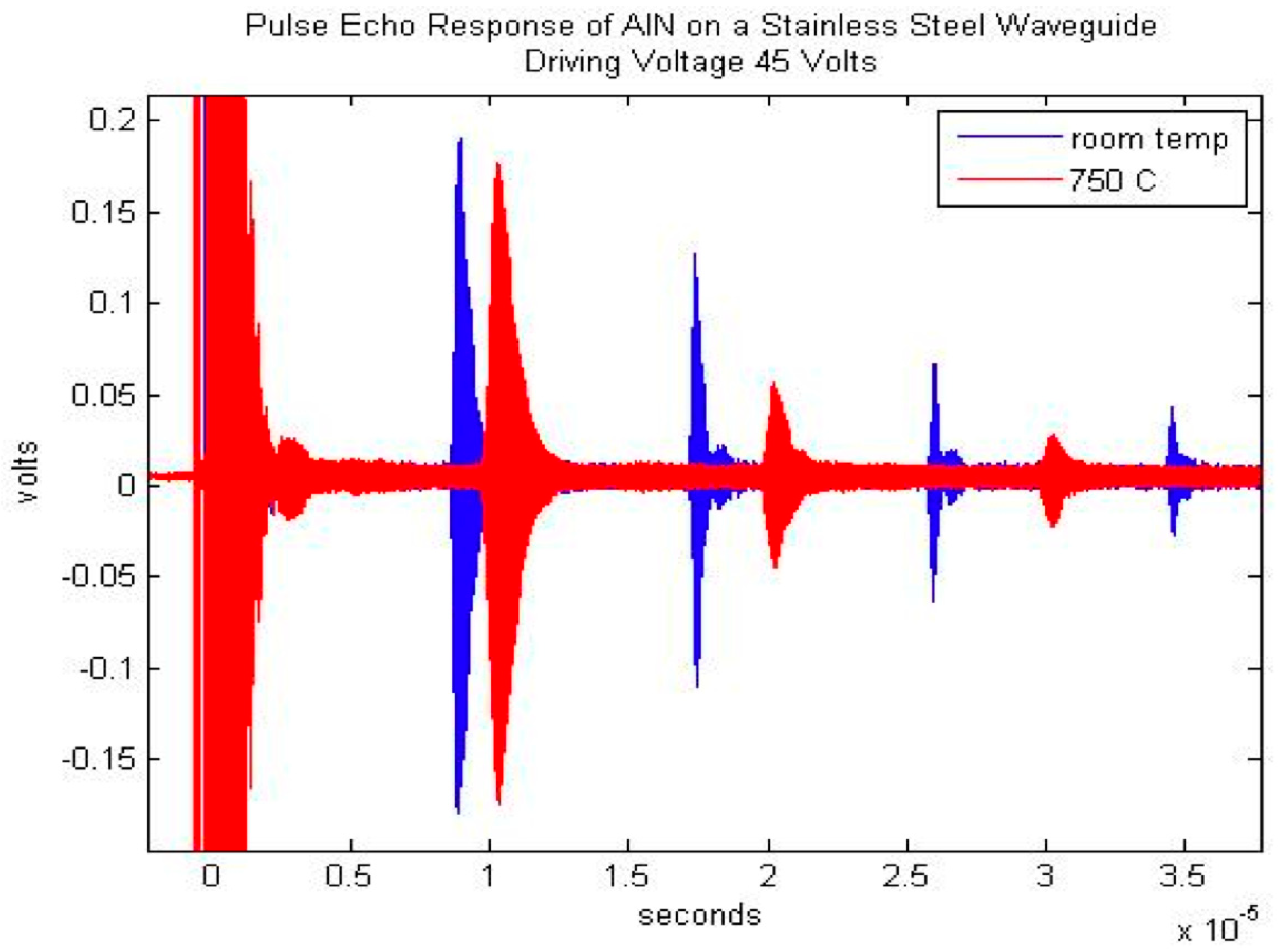

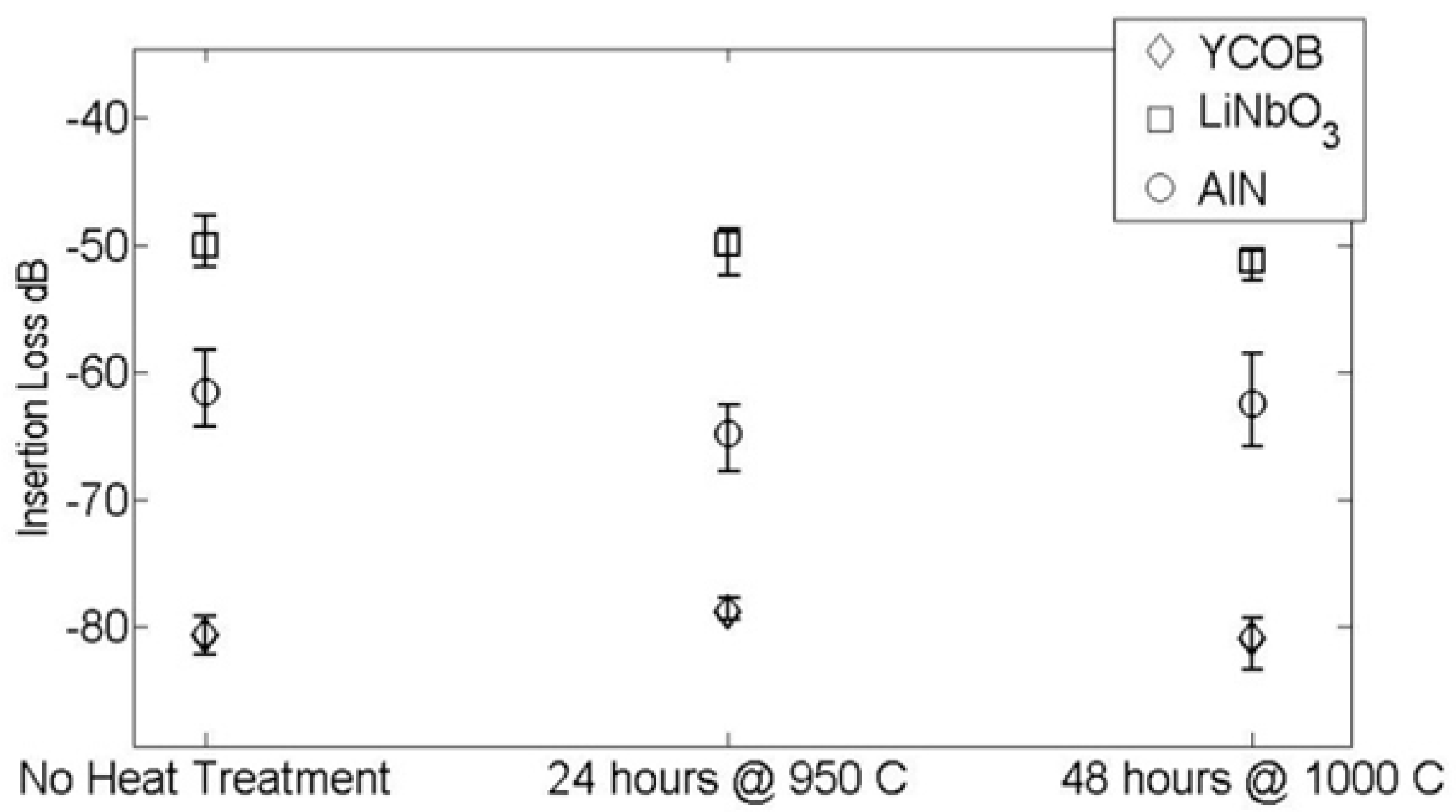
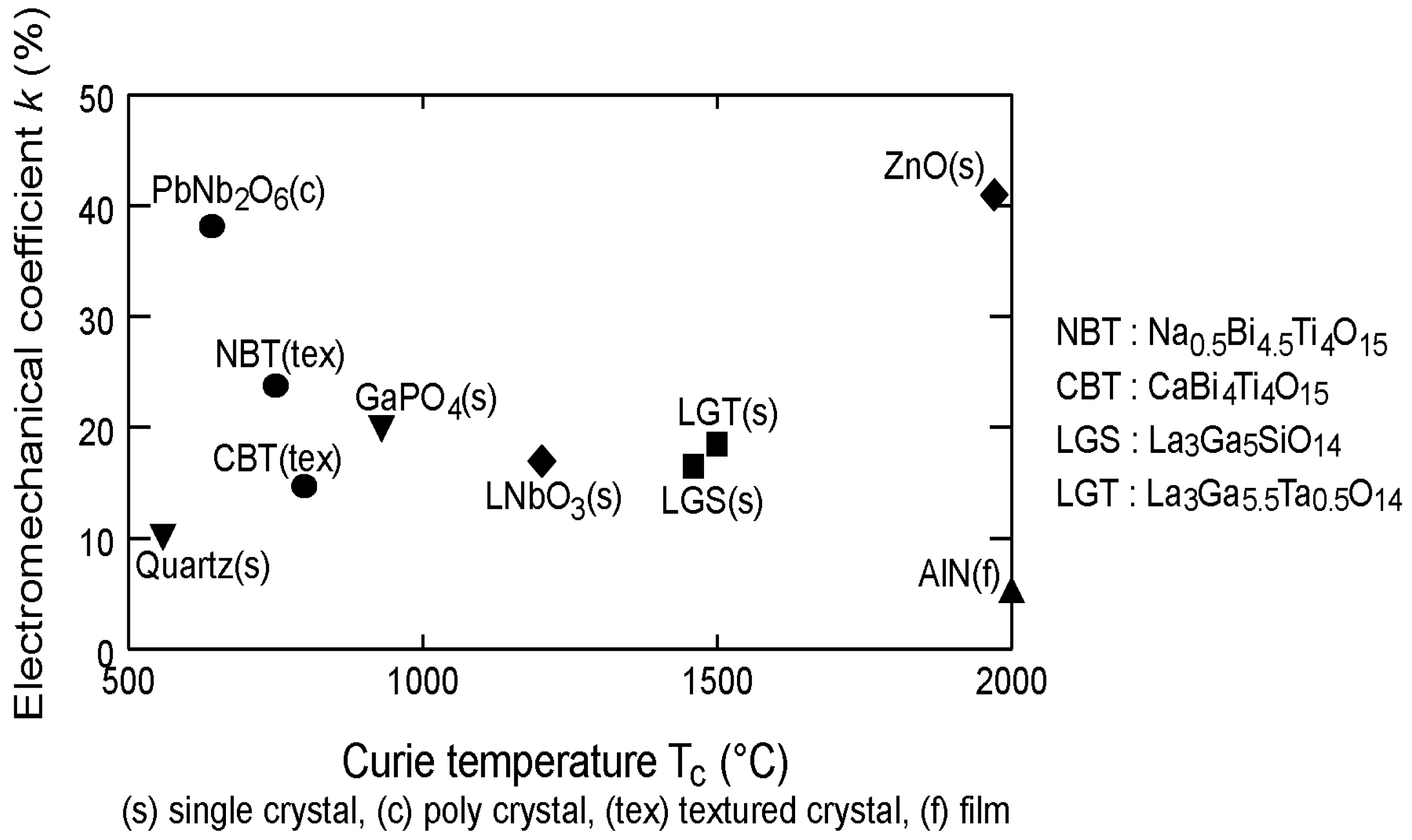
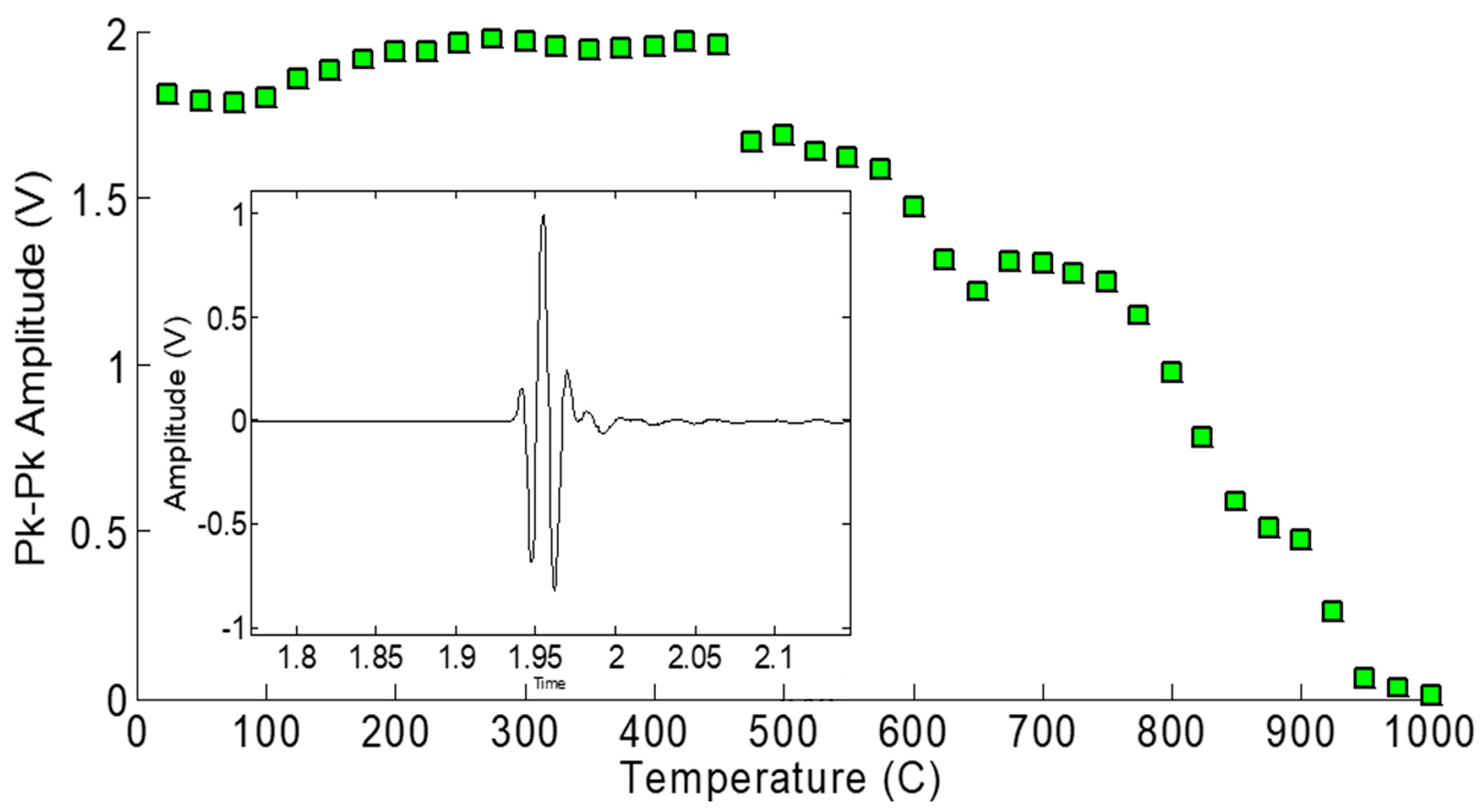


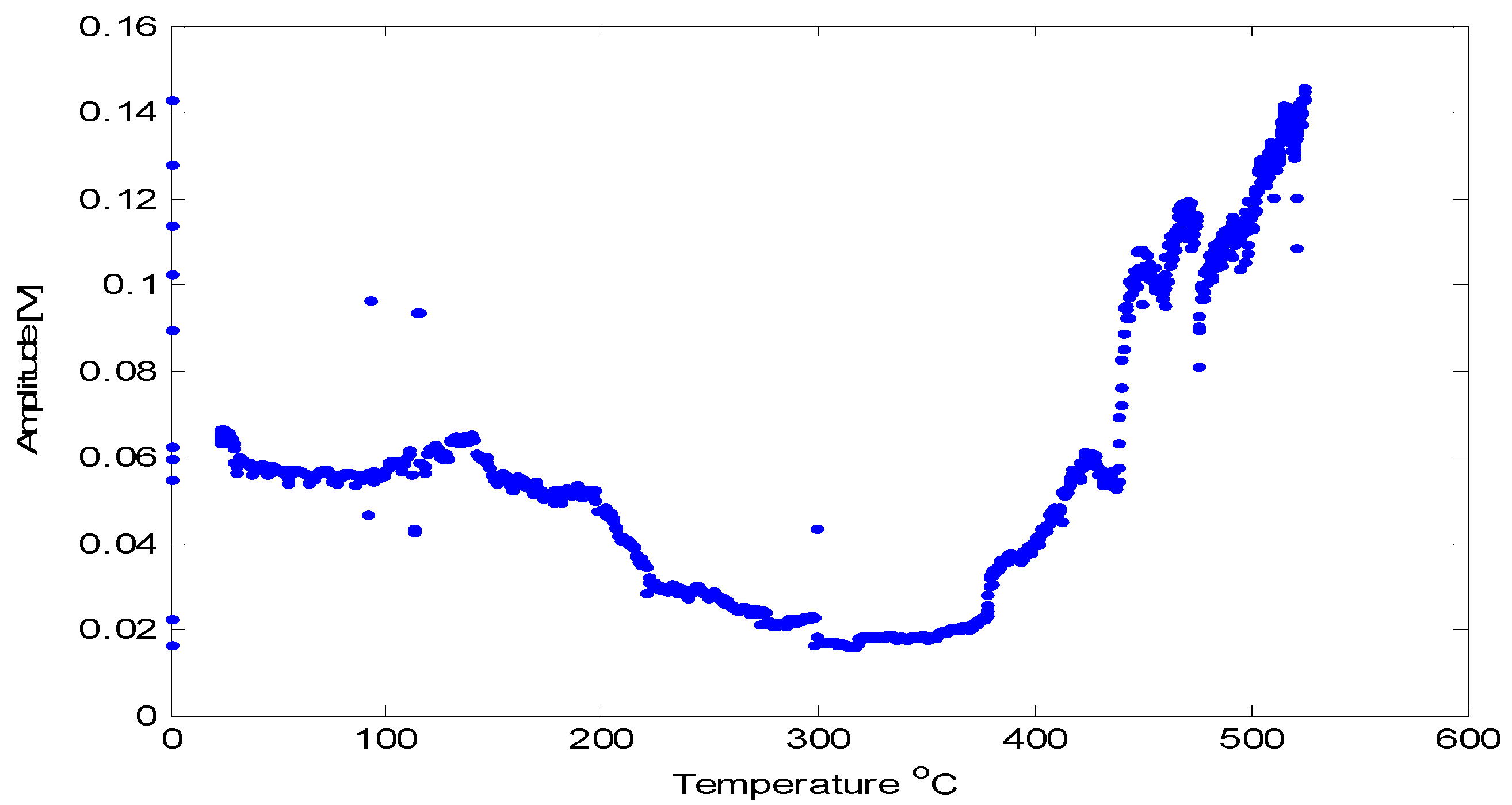



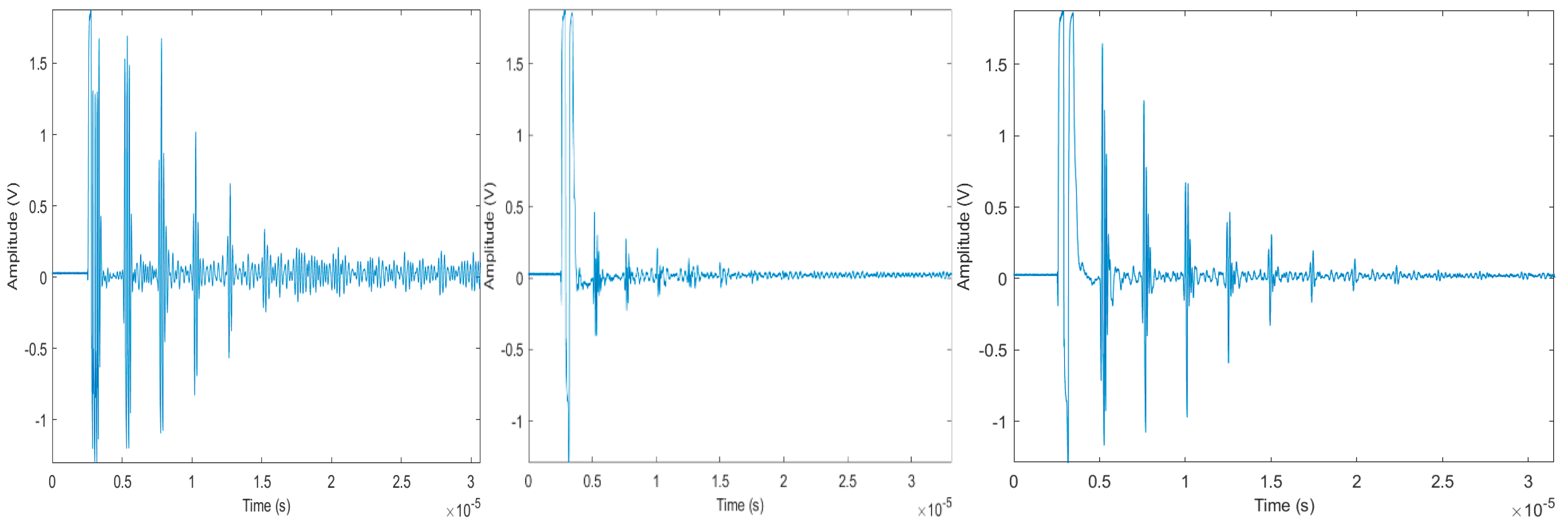




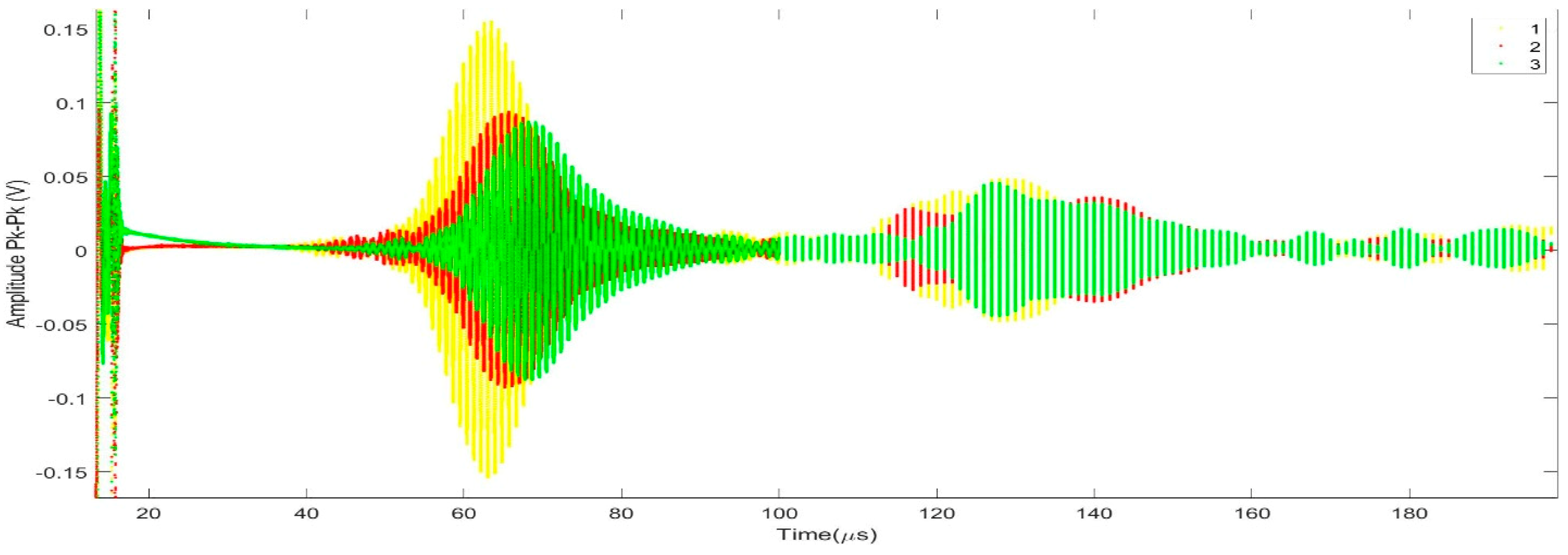
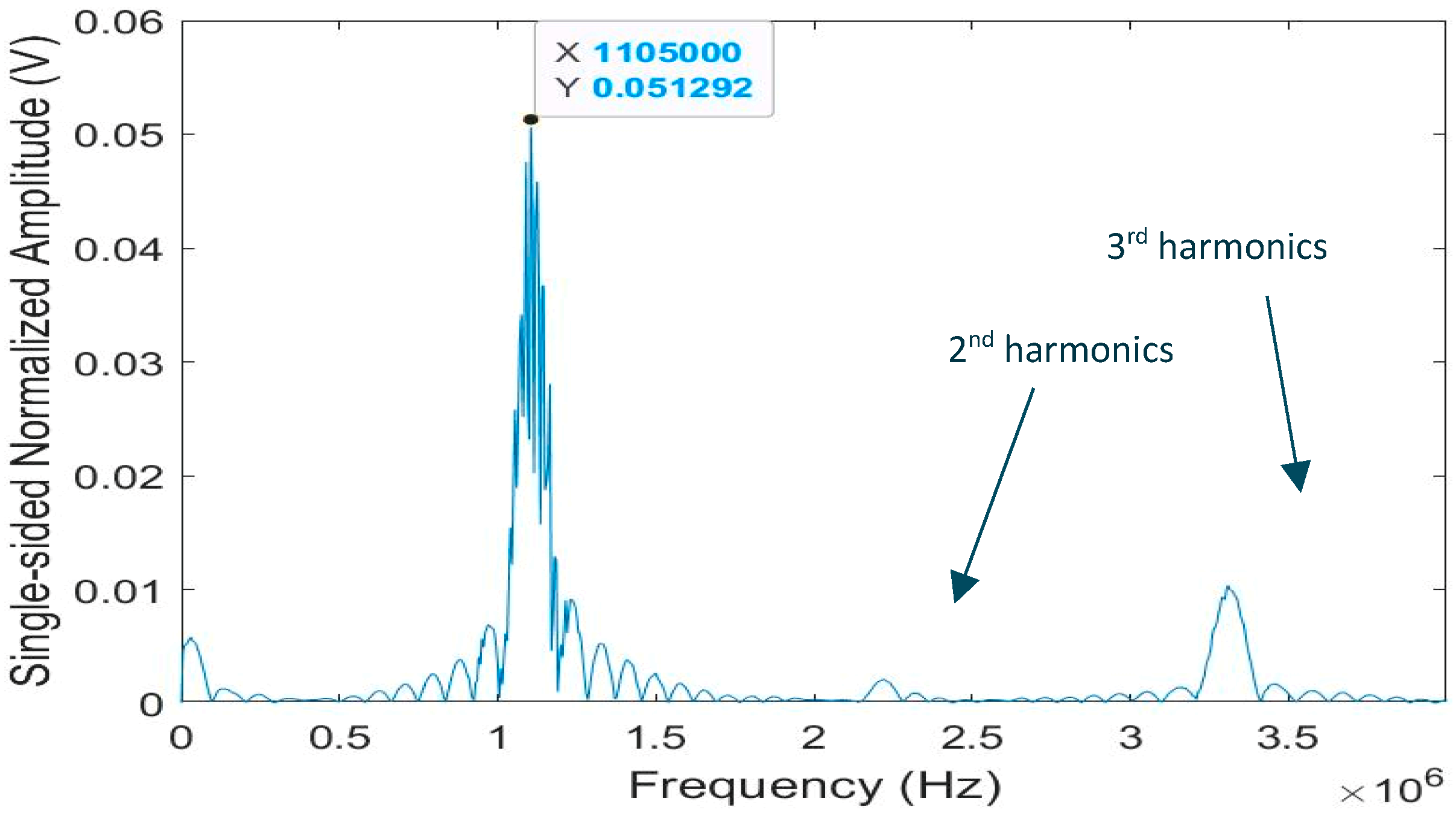
| Piezoelectric Material | Curie–Weiss Temperature (°C) |
|---|---|
| PZT-5H | 210 |
| Keramos lead metaniobate | 400 |
| Bismuth titanate | 685 |
| Lithium niobate | 1000 |
| Piezoelectric Material | Curie Temperature (°C) |
|---|---|
| Praseodymium titanate | >1550 [11,12] |
| Lanthanum titanate | 1461 [13,16] |
| Neodymium titanate | 1482 [13,17] |
| Strontium niobate | 1327 [14] |
| Calcium niobate | >1525 [15] |
| Material | Transition Temperature °C | Transition Type | Structure |
|---|---|---|---|
| AlN | 2826 | Melt | Wurtzite [6] |
| Bi3TiNbO9 | 909 | Curie | Perovskite layered [32] |
| LiNbO3 | ~1200 | Curie | Perovskite [21] |
| Sr2Nb2O73 | 1342 | Curie | Perovskite layered [32] |
| La2Ti2O7 | 1500 | Curie | Perovskite layered [32] |
| GaPO4 | 970 | α-β | SiO2 homeotype [32] |
| ReCa4(BO3)3, Re as Rare Earth element | >1500 | Melt | Oxyborate homeotype [32] |
| ZnO | 1975 | Melt | Wurtzite [33] |
| The Massachusetts Institute of Technology Reactor is characterized by the following features: |
| Total flux = 1.89 × 1014 n/cm2 |
| Thermal flux (<0.4 eV) = 2.12 × 1013 n/cm2 |
| Epi-thermal flux (0.4 eV–0.1 MeV) = 8.03 × 1013 n/cm2 |
| Fast flux 1 (>0.1 MeV) = 8.78 × 1013 n/cm2 |
| Fast flux 2 (>1.0 MeV) = 4.05 × 1013 n/cm2 |
| Gamma dose rate: 1 × 109 r/h |
| Temperature: 400–500 °C |
| Film | Bi4Ti3O12 | LiNbO3 | Organic Bi4Ti3O12 |
|---|---|---|---|
| Signal window (μs) | 5.071–5.739 | 5.071–5.554 | 5.030–5.635 |
| Noise window (μs) | 5.756–7.510 | 5.615–7.490 | 5.675–7.450 |
| Signal strength pk-pk (V) | 2.895 | 0.868 | 2.815 |
| Noise strength pk-pk (V) | 0.267 | 0.156 | 0.284 |
| Signal rms (V) | 1.024 | 0.307 | 0.996 |
| Noise rms (V) | 0.094 | 0.055 | 0.100 |
| Signal strength (dB) | 9.321 | −1.232 | 8.990 |
| Noise strength (dB) | −11.484 | −16.157 | −10.939 |
| Signal-to-noise ratio (dB) | 20.716 | 14.926 | 19.929 |
© 2019 by the authors. Licensee MDPI, Basel, Switzerland. This article is an open access article distributed under the terms and conditions of the Creative Commons Attribution (CC BY) license (http://creativecommons.org/licenses/by/4.0/).
Share and Cite
Tittmann, B.R.; Batista, C.F.G.; Trivedi, Y.P.; Lissenden, C.J., III; Reinhardt, B.T. State-of-the-Art and Practical Guide to Ultrasonic Transducers for Harsh Environments Including Temperatures above 2120 °F (1000 °C) and Neutron Flux above 1013 n/cm2. Sensors 2019, 19, 4755. https://doi.org/10.3390/s19214755
Tittmann BR, Batista CFG, Trivedi YP, Lissenden CJ III, Reinhardt BT. State-of-the-Art and Practical Guide to Ultrasonic Transducers for Harsh Environments Including Temperatures above 2120 °F (1000 °C) and Neutron Flux above 1013 n/cm2. Sensors. 2019; 19(21):4755. https://doi.org/10.3390/s19214755
Chicago/Turabian StyleTittmann, Bernhard R., Caio F.G. Batista, Yamankumar P. Trivedi, Clifford J. Lissenden, III, and Brian T. Reinhardt. 2019. "State-of-the-Art and Practical Guide to Ultrasonic Transducers for Harsh Environments Including Temperatures above 2120 °F (1000 °C) and Neutron Flux above 1013 n/cm2" Sensors 19, no. 21: 4755. https://doi.org/10.3390/s19214755
APA StyleTittmann, B. R., Batista, C. F. G., Trivedi, Y. P., Lissenden, C. J., III, & Reinhardt, B. T. (2019). State-of-the-Art and Practical Guide to Ultrasonic Transducers for Harsh Environments Including Temperatures above 2120 °F (1000 °C) and Neutron Flux above 1013 n/cm2. Sensors, 19(21), 4755. https://doi.org/10.3390/s19214755







